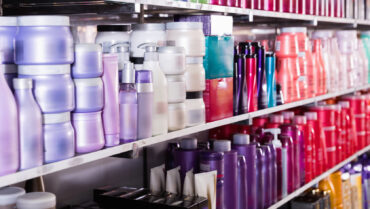

The clean beauty movement is booming. Consumers’ desire to purchase safe cosmetics is understandable, but some of the marketing strategies employ exaggerated claims about the dangers of other cosmetic products’ ingredients. This may cause consumers to develop an unwarranted fear of chemicals and names that sound like chemicals. Although in their raw form or at high concentrations, certain ingredients can have adverse effects, cosmetic products are carefully formulated for safety and effectiveness. Interestingly, some compounds deemed clean by the beauty industry may have more allergenic ingredients than counterparts not marketed as clean.1,2
This article discusses how marketers may misinterpret or misrepresent information on cosmetic ingredients to sell a clean beauty product. To combat the fearmongering patients may encounter in cosmetics advertising, eye care professionals must draw on scientifically supported information.
EXAMPLE
Countering unfounded claims in beauty marketing requires an awareness of regulatory approvals, safety testing results, and scientific research. A recent Instagram campaign for wrinkle sheet masks, for example, featured the slogan plants, not PEGs. In addition to containing significant errors, overextrapolation, and misinformation, a post from the campaign called out three specific ingredients in a popular mask.
Polyethylene glycol 60. The campaign slogan implies that compounds of polyethylene glycol (PEG) are dangerous and inferior to plants. It is worth noting that PEG compounds such as PEG-8 distearate, PEG-8 laurate, and PEG-12 laurate are actually derived from plants.3 The use of PEGylated oils in cosmetics is considered safe3,4 and is approved by the FDA in up to 50% quantities.5 The post claimed that PEG-60 hydrogenated castor oil can contain potentially harmful amounts of 1,4 dioxane, a byproduct created during the PEGylation of castor oil.6 Although 1,4 dioxane is known to be harmful, it is currently regulated to less than 10 ppm, at which level it has no deleterious effects on humans.7 According to a 2008 survey by the FDA, 80% of the cosmetic products tested contained no 1,4 dioxane, and 92% contained less than 10 ppm.7
Propylene glycol. The Instagram post claimed that propylene glycol, a commonly used humectant, is dangerous because it is a petrochemical. Although propylene glycol is a petroleum-derived product, this does not necessarily mean it is dangerous. An expert panel reported in the International Journal of Toxicology that propylene glycol is safe in cosmetics when formulated to be nonsensitizing.8
Disodium ethylenediaminetetraacetic acid. The Instagram post claimed that disodium ethylenediaminetetraacetic acid (better known as EDTA) is derived from toxic chemicals, specifically formaldehyde and sodium cyanide. Disodium EDTA, however, is approved for use in cosmetics and has been found to be safe at concentrations of less than 2%.9
COUNSELING AND CONCLUSIONS: MORE THAN FACE VALUE
Physicians can advise patients that some current marketing strategies for clean cosmetics are not based on science. For instance, many of the claims made in the example discussed in this article do not hold up to scientific evidence, physiologic reasoning, or current regulatory, manufacturing, and contamination standards for cosmetics set forth by the FDA.10
Misleading claims can cause consumers unnecessary anxiety and prompt them to avoid certain compounds. Eye care professionals can respond by directing patients to credible scientific, regulatory, and cosmetics chemistry information so they can make knowledgeable decisions about products.10,11
1. Gui M, Zhang D, Tran JM, et al. The hoax of clean beauty and associated allergens. Curr Derm Rep. Published online August 15, 2023. doi:10.1007/s13671-023-00399-4
2. Slomski A. Almost all “natural” skin care products contain contact allergens. JAMA. 2022;328(17):1677.
3. Jang HJ, Shin CY, Kim KB. Safety evaluation of polyethylene glycol (PEG) compounds for cosmetic use. Toxicol Res. 2015;31(2):105-136.
4. Fruijtier-Pölloth C. Safety assessment on polyethylene glycols (PEGs) and their derivatives as used in cosmetic products. Toxicology. 2005;214(1-2):1-38.
5. The 2012 Cosmetic Ingredient Review Expert Panel. Amended Safety Assessment of PEGylated Oils as Used in Cosmetics. January 18, 2013. Accessed November 29, 2023. https://www.cir-safety.org/sites/default/files/pegoil122012final_faa-final%20for%20posting.pdf
6. Konduracka E, Krzemieniecki K, Gajos G. Relationship between everyday use cosmetics and female breast cancer. Pol Arch Med Wewn. 2014;124(5):264-269.
7. 1,4-dioxane in cosmetics: a manufacturing byproduct. US Food & Drug Administration. Updated March 3, 2033. Accessed September 21, 2023. https://www.fda.gov/cosmetics/potential-contaminants-cosmetics/14-dioxane-cosmetics-manufacturing-byproduct
8. Fiume MM, Bergfeld WF, Belsito DV, et al. Safety assessment of propylene glycol, tripropylene glycol, and PPGs as used in cosmetics. Int J Toxicol. 2012;31(5 suppl):245S-260S.
9. Hedta T. Safety assessment of EDTA, calcium disodium EDTA. Semantic Scholar. 2001. Accessed September 21, 2023. https://www.semanticscholar.org/paper/Safety-Assessment-of-EDTA-%2C-Calcium-Disodium-EDTA-Hedta/78b33857aa52d58dc9b5d66e63a5624b6270b798
10. Modernization of cosmetics regulation act of 2022 (MoCRA). US Food & Drug Administration. November 1, 2023. Accessed November 6, 2023. https://www.fda.gov/cosmetics/cosmetics-laws-regulations/modernization-cosmetics-regulation-act-2022-mocra
11. Romanowski P. A case against the EWG. The Eco Well. June 28, 2019. Accessed November 6, 2023. https://www.theecowell.com/blog/a-case-against-the-ewg




